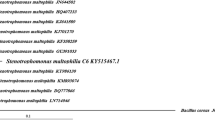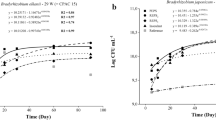Abstract
Bacterial surface molecules have an important role in the rhizobia-legume symbiosis. Ensifer meliloti (previously, Sinorhizobium meliloti), a symbiotic Gram-negative rhizobacterium, produces two different exopolysaccharides (EPSs), termed EPS I (succinoglycan) and EPS II (galactoglucan), with different functions in the symbiotic process. Accordingly, we undertook a study comparing the potential differences in alfalfa nodulation by E. meliloti strains with differences in their EPSs production. Strains recommended for inoculation as well as laboratory strains and native strains isolated from alfalfa fields were investigated. This study concentrated on EPS-II production, which results in mucoid colonies that are dependent on the presence of an intact expR gene. The results revealed that although the studied strains exhibited different phenotypes, the differences did not affect alfalfa nodulation itself. However, subtle changes in timing and efficacy to the effects of inoculation with the different strains may result because of other as-yet unknown factors. Thus, additional research is needed to determine the most effective inoculant strains and the best conditions for improving alfalfa production under agricultural conditions.




Similar content being viewed by others
References
Abdelhadi LO, Lyons TP, Jacques KA (2004) Evaluating inoculants for forage crops in Argentine beef and milk grazing systems: effects on silage quality and system profitability. In: Lyons TP, Jacques KA (Eds.) Nutritional biotechnology in the feed and food industries. Alltech 20th Annual Symposium. Nicholasville, KY, USA pp. 171–177.
Agnusdei MG, Assuero SG, Lattanzi FA, Marino MA (2010) Critical N concentration can vary with growth conditions in forage grasses: implications for plant N status assessment and N deficiency diagnosis. Nutr Cycl Agroecosys 88:215–230
Arelovich HM, Bravo RD, Martínez MF (2011) Development, characteristics, and trends for beef cattle production in Argentina. Anim Front 1:37–45
Avci MA, Ozkose A, Tamkoc A (2013) Determination of yield and quality characteristics of alfalfa (Medicago sativa l.) varieties grown in different locations. J Amin Vet Adv 12:487–490
Bogino P, Abod A, Nievas F, Giordano W (2013) Water-limiting conditions alter the structure and biofilm-forming ability of bacterial multispecies communities in the alfalfa rhizosphere. PLoS ONE 8(11):e79614
Caviglia OP, Andrade FH (2010) Sustainable intensification of agriculture in the Argentinean Pampas: capture and use efficiency of environmental resources. Am J Plant Sci Biotechnol 3:1–8
Charoenpanich P, Becker A, Soto MJ, McIntosh M (2015) Quorum sensing restrains growth and is rapidly inactivated during domestication of Sinorhizobium meliloti. Environ Microbiol Rep 7:373–382
Denarié J, Debellé F, Promé JC (1996) Rhizobium lipo-chitooligosaccharide nodulation factors: signaling molecules mediating recognition and morphogenesis. Annu Rev Biochem 65:503–535
Doherty D, Leigh JA, Glazebrook J, Walker GC (1988) Rhizobium meliloti mutants that overproduce the R. meliloti acidic calcofluor-binding exopolysaccharide. J Bacteriol 170:4249–4256
Evans LT (1993) Crop evolution. Adaptations and yield. Cambridge University Press, Cambridge
Fraysse NF, Couderc F, Poinsot V (2003) Surface polysaccharide involvement in establishing the Rhizobium-legume symbiosis. Eur J Biochem 270:1365–1380
Fujishige NA, Kapadia NN, De Hoff PL, Hirsch AM (2006) Investigations of Rhizobium biofilm formation. FEMS Microbiol Ecol 56:195–205
Fujishige NA, Jankaew K, Hirsch AM (2008) Biofilm formation in Sinorhizobium meliloti. Biology of plant-microbe interactions, Volume 6. In: Proceedings of the 13th International Congress on Molecular Plant-Microbe Interactions. Eds. Lorito M, Woo SL, and Scala F. ISBN 0965462552
Garcia AN, Ayub ND, Fox AR, Gomez MC, Dieguez MJ, Pagano EM, Berini CA, Muschietti JP, Soto G (2014) Alfalfa snakin-1 prevents fungal colonization and probably coevolved with rhizobia. BMC Plant Biol 14:248
Geisseler D, Horwath WR (2016) Alfalfa production in California. https://apps1.cdfa.ca.gov/FertilizerResearch/docs/Alfalfa_Production_CA.pdf. Accessed 16 Apr 2019
Giordano W, Hirsch A (2004) The expression of MaEXP1, a Melilotus alba expansin gene is up-regulated during the sweetclover-Sinorhizobium meliloti interaction. Mol Plant Microbe Interact 17:613–622
Glazebrook J, Walker GC (1989) A novel exopolysaccharide can function in place of the calcofluor-binding exopolysaccharide in nodulation of alfalfa by Rhizobium meliloti. Cell 56:661–672
González JE, York GM, Walker GC (1996) Rhizobium meliloti exopolysaccharides: synthesis and symbiotic function. Gene 179:141–146
Herridge D, Peoples M, Boddey R (2008) Global inputs of biological nitrogen fixation in agricultural systems. Plant Soil 311:1–18
Hirsch AM (1999) Role of lectins (and rhizobial exopolysaccharides) in legume nodulation. Curr Opin Plant Biol 2:320–326
Hirsch AM, Lum MR, Fujishige NA (2009) Microbial encounters of a symbiotic kind- attaching to roots and other surfaces. In: Emons AMC, Ketelaar T (eds) Root hairs. Plant cell monographs, 12th edn. Springer, Berlin, pp 295–314
Janczarek M, Rachwal K, Marzec A, Grzadziel J, Palusinska-Szysz M (2014) Signal molecules and cell-surface components involved in early stages of the legume–Rhizobium interactions. Appl Soil Ecol 85:94–113
Jones KM, Kobayashi H, Davies BW, Taga ME, Walker GC (2007) How rhizobial symbionts invade plants: the Sinorhizobium-Medicago model. Nat Rev Microbiol 5:619–633
Jozefkowicz C, Brambilla S, Frare R, Stritzler M, Piccinetti C, Puente M, Berini C, Reyes Pérez P, Soto G, Ayub N (2017a) Stable symbiotic nitrogen fixation under water-deficit field conditions by a stress-tolerant alfalfa microsymbiont and its complete genome sequence. J Biotechnol 263:52–54
Jozefkowicz C, Brambilla S, Frare R, Stritzler M, Puente M, Piccinetti C, Soto G, Ayub N (2017b) Microevolution rather than large genome divergence determines the effectiveness of legume-rhizobia symbiotic interaction under field conditions. J Mol Evol 85:79–83
Kawaharada Y, Kelly S, Nielsen MW, Hjuler CT, Gysel K, Muszyński A, Carlson RW, Thygesen MB, Sandal N, Asmussen MH, Vinther M, Andersen SU, Krusell L, Thirup S, Jensen KJ, Ronson CW, Blaise M, Radutoiu S, Stougaard J (2015) Receptor-mediated exopolysaccharide perception controls bacterial infection. Nature 523:308–312
Keller M, Roxlau A, Weng WM, Schmidt M, Quandt J, Niehaus K, Jording D, Arnold W, Pühler A (1995) Molecular analysis of the Rhizobium meliloti mucR gene regulating the biosynthesis of the exopolysaccharides succinoglycan and galactoglucan. Mol Plant Microbe Interact 8:267–277
Kneen BE, LaRue TA (1983) Congo red absorption by Rhizobium leguminosarum. Appl Environ Microbiol 45:340–342
López SMY, Molina Sánchez MD, Pastorino GN, Franco MEE, García NT, Balatti PA (2018) Nodulation and delayed nodule senescence: strategies of two Bradyrhizobium japonicum isolates with high capacity to fix nitrogen. Curr Microbiol 75:997–1005
Marketon MM, González JE (2002) Identification of two quorum-sensing systems in Sinorhizobium meliloti. J Bacteriol 184:3466–3475
Martínez-Hidalgo P, Hirsch AM (2017) The nodule microbiome: N2-fixing rhizobia do not live alone. Phytobiomes 1:70–82
Meade HM, Long SR, Ruvkun GB, Brown SE, Ausubel FM (1982) Physical and genetic characterization of symbiotic and auxotrophic mutants of Rhizobium meliloti induced by transposon Tn5 mutagenesis. J Bacteriol 149:114–122
Ohyama T (2017) The role of legume-Rhizobium symbiosis in sustainable agriculture. In: Sulieman S, Tran LS (eds) Legume nitrogen fixation in soils with low phosphorus availability. Springer, Cham, pp 1–20
Pellock BJ, Teplitski M, Boinay RP, Bauer WD, Walker GC (2002) A LuxR homolog controls production of symbiotically active extracellular polysaccharide II by Sinorhizobium meliloti. J Bacteriol 184:5067–5076
Reuber TL, Walker GC (1993) Biosynthesis of succinoglycan, a symbiotically important exopolysaccharide of Rhizobium meliloti. Cell 74:269–280
Rinaudi L, Fujishige NA, Hirsch AM, Banchio E, Zorreguieta A, Giordano W (2006) Effects of nutritional and environmental conditions on Sinorhizobium meliloti biofilm formation. Res Microbiol 157:867–875
Rinaudi LV, González JE (2009) The low-molecular-weight fraction of exopolysaccharide II from Sinorhizobium meliloti is a crucial determinant of biofilm formation. J Bacteriol 191:7216–7224
Rinaudi LV, Giordano W (2010) An integrated view of biofilm formation in rhizobia. FEMS Microbiol Lett 304:1–11
Simon R, Hötte B, Klauke B, Kosier B (1991) Isolation and characterization of insertion sequence elements from gram-negative bacteria by using new broad-host-range, positive selection vectors. J Bacteriol 173:1502–1508
Skorupska A, Janczarek M, Marczak M, Mazur A, Król J (2006) Rhizobial exopolysaccharides: genetic control and symbiotic functions. Microb Cell Fact 16(5):7
Sorroche F, Bogino P, Russo DM, Zorreguieta A, Nievas F, Morales GM, Hirsch AM, Giordano W (2018) Cell autoaggregation, biofilm formation, and plant attachment in a Sinorhizobium meliloti lpsB mutant. Mol Plant Microbe Interact 31:1075–1082
Sorroche F, Giordano W (2012) PCR analysis of expR gene regulating biosynthesis of exopolysaccharides in Sinorhizobium meliloti. Biochem Mol Biol Educ 40:108–111
Sorroche F, Rinaudi L, Zorreguieta A, Giordano W (2010) EPS II-dependent autoaggregation of Sinorhizobium meliloti planktonic cells. Curr Microbiol 61:465–470
Sorroche F, Spesia MB, Zorreguieta A, Giordano W (2012) A positive correlation between bacterial autoaggregation and biofilm formation in native Sinorhizobium meliloti isolates from Argentina. Appl Environ Microbiol 78:4092–4101
Vicario JC, Primo ED, Dardanelli MS, Giordano W (2015) Promotion of peanut growth by co-inoculation with selected strains of Bradyrhizobium and Azospirillum. J Plant Growth Regul 35:413–419
Wells DH, Chen EJ, Fisher RF, Long SR (2007) ExoR is genetically coupled to the ExoS-ChvI two-component system and located in the periplasm of Sinorhizobium meliloti. Mol Microbiol 64:647–664
Zhan HJ, Lee CC, Leigh JA (1991) Induction of the second exopolysaccharide (EPSb) in Rhizobium meliloti SU47 by low phosphate concentrations. J Bacteriol 173:7391–7394
Acknowledgements
Grants from the Secretaría de Ciencia y Técnica de la UNRC, Agencia Nacional de Promoción Científica y Tecnológica (ANPCyT) and Consejo Nacional de Investigaciones Científicas y Técnicas of the República Argentina (CONICET) supported this work. EP and SC have a fellowship from the CONICET. FN, PB, and WG are Career Members of CONICET. Our thanks are due to Dr. Nicolás Ayub for helpful suggestions and useful discussions. Support from a Shanbrom Family Fund grant supported research on symbioses in arid environments in the Hirsch laboratory. This research was funded by FONCyT Grant number [PICT 1528/15].
Author information
Authors and Affiliations
Corresponding author
Ethics declarations
Conflict of interest
The authors have no conflicts of interest to declare.
Additional information
Communicated by Erko Stackebrandt.
Publisher's Note
Springer Nature remains neutral with regard to jurisdictional claims in published maps and institutional affiliations.
Electronic supplementary material
Below is the link to the electronic supplementary material.
Rights and permissions
About this article
Cite this article
Primo, E.D., Cossovich, S., Nievas, F. et al. Exopolysaccharide production in Ensifer meliloti laboratory and native strains and their effects on alfalfa inoculation. Arch Microbiol 202, 391–398 (2020). https://doi.org/10.1007/s00203-019-01756-3
Received:
Revised:
Accepted:
Published:
Issue Date:
DOI: https://doi.org/10.1007/s00203-019-01756-3




